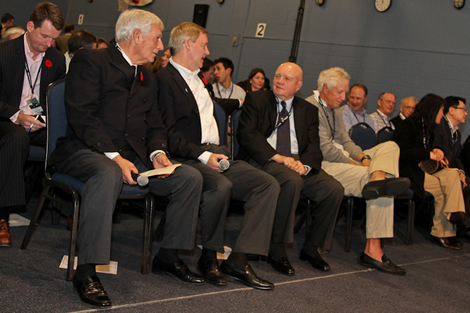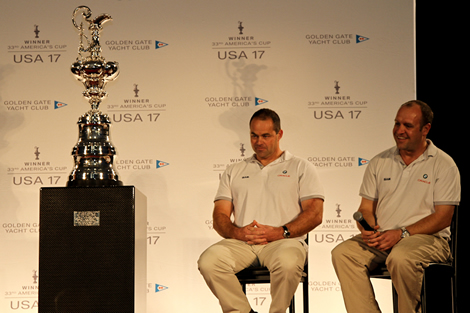Canada's fifth ever America's Cup challenger
Canada could well be making its fifth appearance in the America’s Cup arena following on from its challenges in 1876, 1888, 1983 and 1987. The final one of these, the combined Secret Cove/TrueNorth, was spearheaded by businessman Paul Phelan who competed in Fremantle in Canada II, a 12 metre designed by Laser creator Bruce Kirby and skippered by Laser World Champion and 1984 Finn bronze medallist, Terry Neilson.
Challenging through the Royal Canadian Yacht Club in Toronto, the newly formed Red Maple Racing is being spearheaded by Kevin Reed and the familiar figure of Paul Henderson. Reed, who retired earlier this year from the world of finance, says he had planned on becoming a cattle rancher for a while. “It turns out that that was short lived because the farm land business is turning into big business, there is a lot of money falling in globally to farm land. My business is mainly finance.”
Henderson was Canada’s Soling and Finn representative at the 1964 and 1968 Olympic Games, but is of course better known for his 10 year tenure as President of ISAF. Operationally Reed handles the business side, the finding of potential sponsors, while Henderson will run the sailing program.

“I have been an America’s Cup fan for three decades,” says Reed. “I am an avid sailor, although I wouldn’t say I am anywhere near any kind of racer, not like Paul Henderson or any of those guys. But I love the area of sailing.”
Like most Canadian kids, Reed grew up with ice hockey as his principle sport and this took him across to Austria where he played for Grazz. “I have always been attracted to sailing, and a lot of the aspects are similar to hockey: the team aspect, no one person usually wins it for you, but one person can certainly lose it for you. So there is a strong element of team work especially in racing, and it is something I always thought I would like to do is to drive an America’s Cup bid.”
Red Maple Racing began to take shape in 2007 when he and Henderson visited Valencia prior to the 32nd America’s Cup. “I thought it was done exceptionally well,” says Reed of that event. “We had a tremendous time there. I learned a lot about the business side of it. As this started to go into America’s Cup 33 and the court battles and the money was being spent, I stepped back and had a pause and went ‘jeez, whoever funds these campaigns, it’s a lot - do you want to get involved in something like that?’ But I would say that with Russell Coutts driving it towards a Formula 1 format, all of a sudden it became very attractive to us in Canada.”
One significant aspect is that Canada is the current holder of the event perhaps most relevant to the new format America’s Cup – the Little America’s Cup – sailed, as the 34th big America’s Cup will be, in solid wingsail catamarans and also with a similar format that culminates in a match race between the chosen challenger and the defender.
“Certainly we are proud of our success in the Little America’s Cup,” says Reed. “But I think the influence for us is multi-faceted. There are a number of great Canadian sailors. Our desire is to be an all-Canadian team. Canada survived the financial meltdown that occurred in a really strong fashion, so our Canadian companies who sell their products around the world have strong balance sheets and are looking to grow. So that bodes well for sponsorship. And the new format that the ACEA and ACRM are proposing is very attractive to us as Canadians from a sponsorship and from a continuum. One thing we desire not to have happen is that we gear up for this and it is only a three year push. We want to run it like a professional sports franchise, where the sailors know, we know as owners and the sponsors know that this is a long term professionally run, sports franchise.”
Reed says that Paul Henderson has been in contact with the Little America’s Cup defender Fred Eaton. Several of Eaton’s team, including his crew and wing co-designer Magnus Clarke, were involved in the BMW Oracle Racing effort to the win the 33rd America’s Cup.
“Paul has to him many times about this,” says Reed of the prospect of Little America’s Cup defender Fred Eaton coming on board. “I don’t want to put words into his mouth, but he is at the very minimum very eager and at the very best he is excited about participating. I don’t want to speak for him, but he will certainly be involved. A guy with his expertise and calibre, it would be foolish not to have him on side. He would bring a lot to the team if we go forward.”
And of course with Eaton comes the designer of his four C-Class cats, Steve Killing, who way back also designed one of the 12 metres for the 1987 Canadian challenge. Then there is Objective 3 Skiffworks, which has built all of Eaton’s C-cats, and who’s Rob Patterson and Rossi Milev, were also part of the squad that helped to keep USA 17 the right way up overnight as she sailed around her mooring in Valencia’s commercial port. Going further back still, it was the Canadian aerospace company Canadair that constructed Mike Birch’s Nigel Irens-designed maxicat Formule TAG (latter ENZA New Zealand) in the early 1980s.
“We do have from both the builders to the designers, a strong base in catamarans and also our sailors have done some pretty good things in the catamaran class,” says Reed.
In terms of sailors, probably the best known from the Cup is BMW Oracle Racing’s Brian MacInnes. Richard Clarke is a leading Star sailor, who was part of John Kostecki’s Volvo Ocean Race winning illbruck Challenge. Ross MacDonald, the two time Star medallist, who is now a regular on the Bribon TP52 on the Audi MedCup, must also surely feature. Curtis Blewitt, the ex-Alinghi, Pirates of the Caribbean bowman, must also feature. Then there are others such as Frank McLaughlin and John Millen who won bronze in the Flying Dutchman in Pusan, the two time Finn Gold Cup winner Hank Lammens, Ross MacDonald’s crew Eric Jespersen, Kai Bjorn and Mike Wolfs and past Canadian Tornado representatives such as David Sweeny and Kevin Smith, who finished 5th the Barcelona Games. Among the newer generation of Olympic sailors, the most promising is perhaps Laser sailor Mike Leigh, who this year came third at Skandia Sail For Gold this year and who won Hyeres in 2008.

“We have spoken to our designated sailing team, most of them, and they are very eager to help in any way,” says Reed, adding that while they have had conversations with potential candidates, they haven’t started formally recruiting yet. “As you know in building a team, it is so important with chemistry. The people we are speaking to, the chemistry between them is phenomenal.
“I would say that if we get the funding mechanism put in place quickly here, we would be on board. We are shaping up to be a good sailing team and a good design and build team that is Canadian and the third aspect is the financing mechanisms and that is what we are now focussed on and that would principally drive our decision which will come probably in mid to late February.”
So will they go for a fully fledged campaign or something more modest? “We are building a campaign to be highly competitive and we are building a campaign for which we hope in a format that will be continued after AC34, so that we can continue the momentum to keep building. We are not coming into this just to enter, we are coming into it to be highly competitive, and in the world of sailing, as in any sport, if you stay in the game and you are competitive, you never know what can happen to your competitors. You can wake up one day and pull off some good surprises.”
Key to their entry is knowing the venue, which in theory should come any day now (BMW Oracle Racing has stated it will become known by the end of this year).
“The interesting part certainly for us is where they are going to park it, whether it is Rhode Island or San Francisco,” says Reed. “I was in Dubai when they thought they had a deal and it seemed to go a little bit sideways when we were over there. It is never done until it’s done. These things are pretty fluid.”
Reed says that it is important for them that the next Cup is in North America. “San Francisco or Rhode Island - either one is good for Canada. From a branding, sponsorship, etc – for a whole bunch of reasons it is good for a Canadian entrant.
“One of the things we have seen as we talk to Canadians and potential sponsors - the Vancouver Olympics was extremely successful and it has given Canadians a good sense of confidence that we can have dreams and we can do these things. Vancouver was a defining moment for Canada for a whole bunch of reasons and we are seeing that translate into a level of interest in the things we are talking about with the America’s Cup.”
Despite the entry process to the 34th America’s Cup being relatively easy and not too painful financially, Reed says they won’t formally enter until they are further down the track with funding. “We are pretty comfortable with what ACEA is asking for in terms of entry. Those are all do-able things. What we don’t want to do is start it and stop it. We’re looking to say - is this an on-going business that we can make a business that is highly competitive out of? And as I say, I want to stress that to do it for three years is not of interest to most of us. We want to build a grass roots group of sailing talent, that one day, like any other pro-sport where they have their farm teams and feeder system, you can build a whole talent pool. For everyone involved, if we go forward, we not just looking for AC34, we are looking to have this as a continuous event.”
Reed concludes: “If there is something I can reinforce: Russell Coutts and his team at the ACRM and ACEA, they have really worked hard to help us as a challenge as they have with other challengers, to look at this and they have worked hard to build it into a do-able event for a lot of countries and a sustainable event. They have worked extremely hard and have done a good job.”









Latest Comments
Add a comment - Members log in